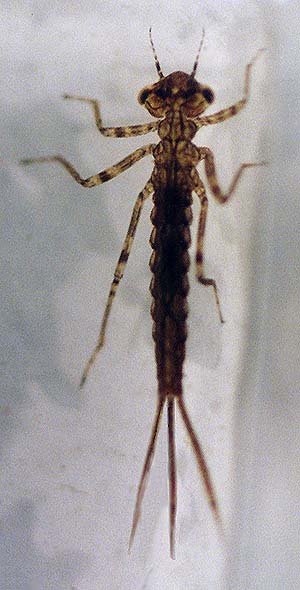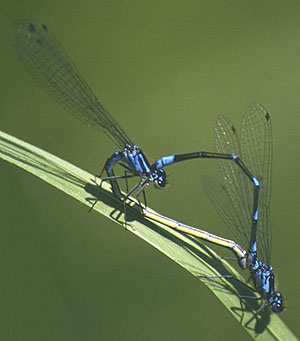
Note three caudal gills
© Thomas Noland 2N Publications
BUG OF THE MONTH: February 1995
Damselflies
Order Odonata, suborder Zygoptera
Copyright © 1995 by Louise Kulzer
This article originally appeared in Scarabogram, Feb. 1996, New Series No. 178, pp. 2-3.
 |
|
Damselfly nymph from an Everett wetland Note three caudal gills © Thomas Noland 2N Publications |
Although in the same order as dragonflies, adult damselflies are slender and more delicate in appearance than their more robust and swifter cousins. They have simple metamorphosis, the nymph stage being aquatic. It takes 10 to 15 molts for the nymphs to emerge and transform into the aerial adult stage, although most damselflies can accomplish this transformation in one year (Cannings 1977). The nymphs are unique in having three caudal lamellae or gills attached to the end of the abdomen. Most damselfly nymphs are predators; some are scavengers as well.
Damselflies are fairly ancient as insects go, harkening back about 300 million years. That's older than flowering plants! No wonder they're predators. It's better than eating cycads or ferns. They haven't altered much in all that time either. Damselflies still retain rather unique and primitive ways of doing a number of things. For instance, damselflies have never evolved a mechanism for folding their wings over the back. Most damselflies raise their wings vertically over the back when at rest, which is slightly more advanced than the Anisoptera (dragonflies), which have to hold the wings spread horizontally.
Another example is their method of mating. Odonata males have accessory genitalia in a pouch on the second segment of the abdomen. The sperm are transferred to this pouch, and a female is pursued and grasped behind the head with the male's anal appendages. The female then curls the tip of her abdomen forward to the accessory genitalia, and fertilization occurs. Although Anisoptera (dragonflies) mate the same way, only the damselflies with their more slender bodies describe a heart shape during copulation (see photo below), a fitting emblem for bug enthusiasts at Valentine's Day. (Ever wonder if male damselflies resent the name?)

|
| Coenagrion pulchellum (Europe) mating © Markku Savela |
The Odonata have muscles attached to each wing, rather than to the thorax itself, as do most other insects. The wings, then, can beat independent of each other. However damselflies are weak fliers, presumably because they don't have as much muscle working the wings as dragonflies. Williams & Feltmate (1992) say that the rustling sound damselflies make in flight is the wings rubbing upon each other as they pass. (I challenge you to look eye-to-eye at one of these weak-flying beauties to see if the wings really beat asynchronously.)
Not unique, but noteworthy nevertheless, is their color. The males, especially, are brightly colored and possess some of the purest blues in the animal kingdom. Green is also a common color for damselflies. Cannings (1977) says some are also bronze, yellow, orange, red, or purple, but I myself have never seen a purple damselfly. Maybe they're just in Canada (or in Ogden Nash).
Damselflies avoid flying unless the sun is out. Picture this: a glint of blue in the sun, the delicate rustle and soft blur of asynchronously beating wings in the still air near a pool: it'd make a bug-lover out of anyone (that is, if the mosquitoes weren't too bad).
There are only 19 species of damselflies in Washington (Paulson 1993). Their diversity is greatest in the neotropics, with many endemic species and evolutionary relicts. Other areas with distinct damselfly faunas include the Orient, Madagascar, Australia and Japan. All in all, I think this would be a good group to specialize in. I just wonder if the IRS will believe all those trips are job-related?
References:
Cannings, Robert A, & K.M. Stuart. 1977. The Dragonflies of British Colombia. British Columbia Provincial Museum, Victoria, Canada, Handbook No. 35.
Paulson, Dennis R. The Dragonflies (Odonata) of Washington, July 1993. Scarabogram 162: 3-4, Oct. 1993.
Walker, Edmund M. 1953. The Odonata of Canada and Alaska. University of Toronto Press.
Williams, D.D. and B.W.Feltmate. 1992. Aquatic Insects. CAB International, Wallingford, U.K.
This page last updated 16 June, 2005